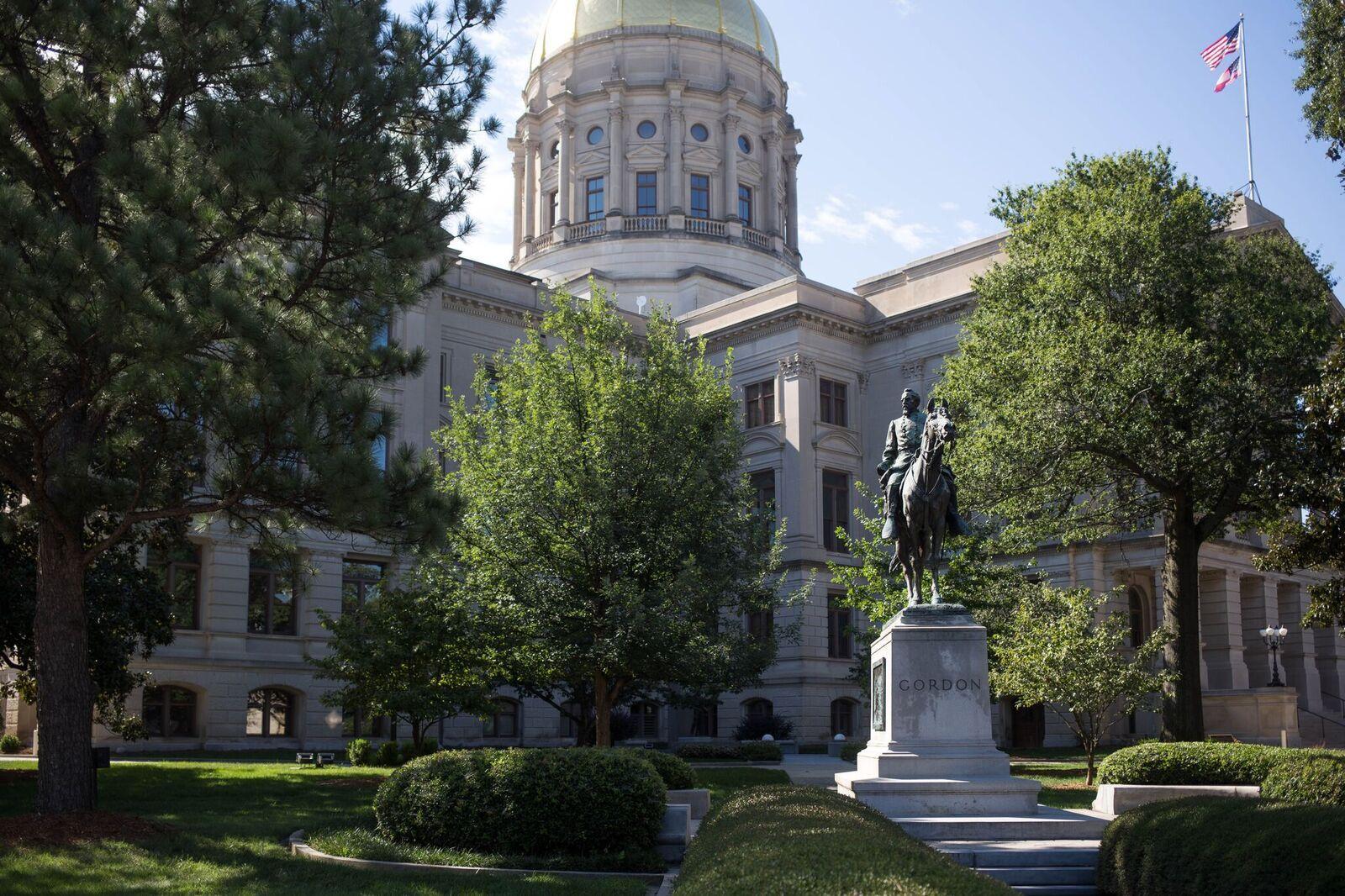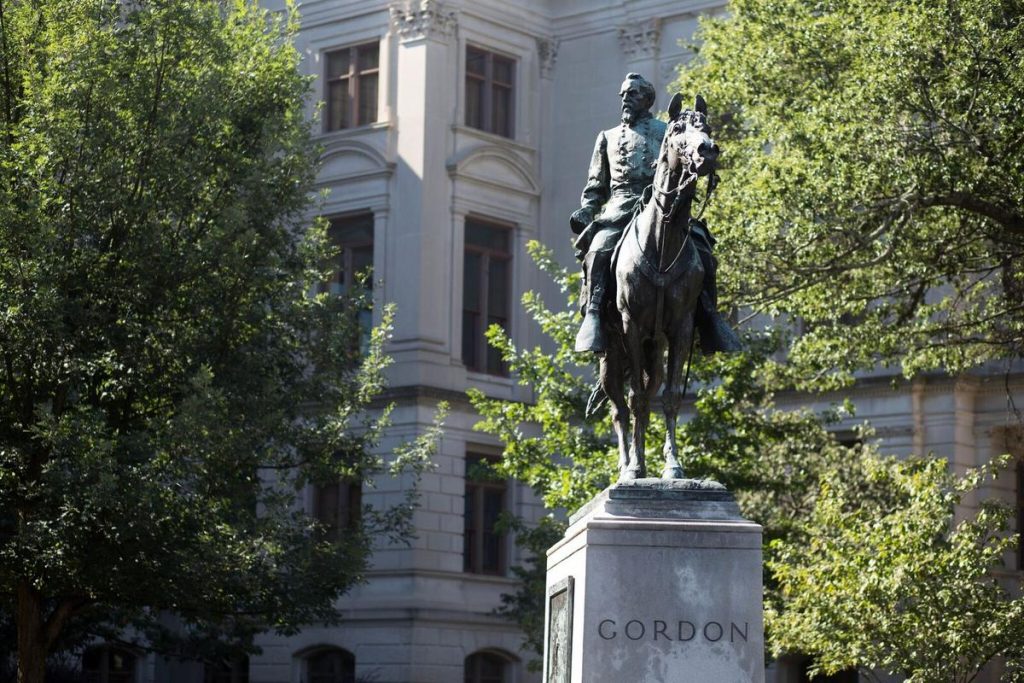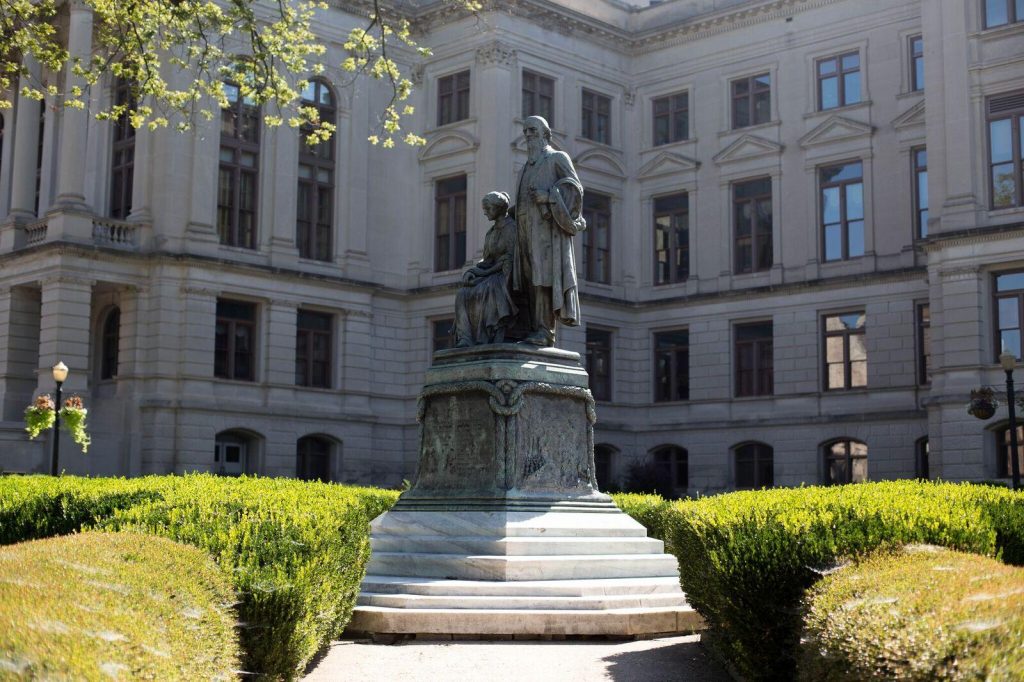Monuments To White Supremacist Men Dominate Ga. Capitol Grounds

The statue of former Confederate general and KKK leader John Brown Gordon is one of the most imposing monuments outside the Georgia State Capitol.
Ian Palmer / WABE
On the 54th anniversary of his famous “I Have a Dream” speech, nearly 50 years after his death and less than a month after an anti-racism protester was allegedly killed by a white supremacist in Charlottesville, Virginia, a statue of Martin Luther King Jr. is scheduled to be erected outside the Georgia State Capitol.
King will be the first black individual to be memorialized on the Capitol grounds, which are dominated by statues of white supremacists like Ku Klux Klan leader John Brown Gordon. Also on the Capitol grounds sits U.S. Sen. Richard Russell, one of the staunchest opponents of the civil rights legislation King pushed for near the end of his life.
The Capitol is host to at least six monuments of white supremacists.
“The King statue will inspire and give hope to generations to come,” said longtime state Rep. Calvin Smyre, a member of the Georgia Legislative Black Caucus. “The day the statue memorializing [King] is unveiled will be a great day in the history of our state and nation.”
While some black state legislators have called for the statues of Gordon, and other segregationists to be removed from the capitol, Smyre wants the focus on King.
“They’ll be an appropriate time to discuss all that,” he said. “But Monday is about the unveiling of Dr. King.”
Before recent violence in Charlottesville, the King statue’s unveiling was already set for Monday.
The statue of KKK leader Gordon sits on the northwest side of the Capitol grounds, across from where the King statue will be installed. The Capitol building sits in between them.
“What [King] had to overcome had been established by John Brown Gordon,” said Georgia State University professor Tim Crimmins. “They’re on opposite sides of the northside of the building, but they represent suppression on the one hand, and the ability, the will to overcome it, and the success of it with Martin Luther King Jr.”
Crimmins wrote a book about the Georgia State Capitol and its monuments, Democracy Restored.
I spoke to him about some of the most prominent monuments on the Capitol grounds. You can find brief summaries of those conversations below:
John Brown Gordon – 1907
One of the most imposing figures outside the Georgia Capitol, John Brown Gordon sits atop a horse in the Confederate uniform he would have worn while a general in that army. He later led the KKK, which carried out violent, terroristic, voter-suppression tactics against black people, helping propel him to political office. Gordon was governor from 1886-90 and U.S. senator from 1891-97. His statue went up at the height of Confederate memorialization efforts in Georgia. In 1832, Gordon was born on a plantation along the Flint River in Upson County. He died in 1904.

Joseph E. Brown and Elizabeth Brown – 1928
Joseph E. Brown was Georgia’s governor during the Civil War, and a U.S. senator from 1880-90. The statue featuring Brown and his wife, Elizabeth, notably sitting next to him, was pushed for by their son, also named Joseph Brown, who became governor in 1909. The senior Brown was a strong supporter of the Ku Klux Klan, segregation and black voter suppression. While governor, Brown was known for pushing back against the Confederate government, challenging the draft. He was born in South Carolina in 1821 and died in 1894.

Tom Watson – 1932
The statue of Tom Watson, with a fist held in the air, may have been the most imposing figure outside the Georgia Capitol before it was recently moved from its spot in front of the west entry, to a more isolated location known as Talmadge Plaza across Washington Street. Watson began his career trying to win black and white voters, but he changed strategies after losing, becoming an advocate of white supremacy. Watson served in the Georgia House of Representatives beginning in 1882, the U.S. House in 1890 and the U.S. Senate in 1920. He died two years later. He’s known for backing a program to bring free mail delivery to rural areas. Watson was born in 1856.
Eugene Talmadge – 1949
Eugene Talmadge may have been the most polarizing figure ever in Georgia politics. Calling it a threat to segregation, Talmadge backed a voting system that disenfranchised blacks even after the U.S. Supreme Court ruled it was unconstitutional. He first became governor in 1933. After winning the seat again in 1946, he died before taking office, triggering what’s known as the “three governors controversy.” It led to his son, Herman, taking the governor’s office in 1947 even though he hadn’t run for office. Just two years later, Herman pushed for the statue of his father to be installed. Eugene Talmadge was born in 1884.
Richard Russell – 1975
For 50 years, Richard Russell held public office. He’s most well known for being a U.S. senator from Georgia. He held that position from 1933 to 1971. Russell led a group of senators in the South in opposing civil rights legislation, effectively blocking its passage for as long as three decades. Over his long career, Russell brought a lot of money and jobs to Georgia that remain today, such as military bases and the Centers for Disease Control and Prevention. The statue of Russell is the largest on the Capitol grounds. He was born in 1897 and died in 1971.
“Expelled Because Of Color” – 1978
The monument titled “Expelled Because of Color” is the only work outside the Capitol honoring any lawmaker who is black. In 1868, a white majority of legislators determined black Georgians did not have the authority to hold office based on the Dred Scot decision from the U.S. Supreme Court. They voted to expel 28 of 32 black legislators from their seats, setting the stage for voter suppression that kept African-Americans out of the Legislature until 1963. The “Expelled Because of Color” monument is meant to honor the struggle of black Georgians fighting for political representation from “the slave ship to the statehouse,” according to its sculptor John Riddle.
Herman Talmadge – 1990
Herman Talmadge, son of Eugene Talmadge, first served as Georgia’s governor for a two-month period in 1947 during the “three governors controversy.” He was elected again in 1948 and served until 1954. In 1956, he was elected to the U.S. Senate, where he served until 1980. In the Senate, he fought hard against desegregation and civil rights legislation. He also gained notoriety for his questioning during the Watergate scandal and financial malfeasance. Talmadge was born in 1913 and died in 2002. His statue sits across the street from the Capitol building in “Talmadge Plaza.”
Jimmy Carter – 1992
Former President Jimmy Carter is Georgia’s most well-known politician. He was elected to the Georgia state Senate in 1962, the governorship in 1971 and the presidency in 1977. During his early political career in Georgia, Carter wasn’t known as a strong advocate for anti-discrimination or desegregation laws, and he ran for governor as a moderate, even voicing his support for a visit to Georgia by segregationist George Wallace of Alabama. Once elected, Carter became outspoken against racism. Telling the Legislature, “I say to you quite frankly that the time for racial discrimination is over.” Carter pushed for paintings of Martin Luther King Jr. and other black leaders to be put up in the state Capitol.
Ellis Arnall – 1997
Ellis Arnall was Georgia governor from 1943-47. He’s known as the progressive opposition to the more conservative Talmadge family who dominated the state politics of the time. He eliminated a poll tax that disenfranchised black voters, arguing soldiers returning from war couldn’t pay it. Although historians call Arnall a segregationist, he refused to defy a U.S. Supreme Court ruling that Georgia’s white-only primary system was unconstitutional. His opponent in the governor’s race at the time, Eugene Talmadge, called him a traitor to the white race. Arnall lost that race. His law firm, Arnall Golden Gregory, pushed for his statue to be erected at the Georgia Capitol. Arnall died in 1992. He was 85.








